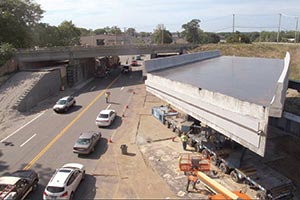Bridge Construction Method Saves States, Drivers Time

This story appears in the Oct. 24 print edition of Transport Topics.
Rhode Island had a pair of bridges in East Providence that were in such poor condition that Vice President Joe Biden termed one of them “shameful” during a visit this spring.
Rather than taking months to replace those bridges while closing lanes and snarling traffic, the state’s Department of Transportation used the increasingly popular accelerated- bridge construction method. One bridge was replaced in just 83 hours from the night of Sept. 9 until the morning of Sept. 13. The other’s replacement was even faster, with the shutdown lasting just 65 hours from the night of Sept. 23 until the morning of Sept. 26.
Accelerated bridge construction uses prefabricated materials to create as many components as possible ahead of time. That allows for the old structure to be rapidly taken down and the replacement constructed as rapidly.
“If we did not use this approach, it would’ve taken a year and the bridge would’ve had half the capacity during construction,” said RIDOT spokesman Charles St. Martin, who noted that one of the replaced bridges had a 17-ton weight limit that had hampered truck traffic for several years. “Twenty thousand cars and trucks would’ve had to share one lane. That would’ve certainly caused more congestion and delay, which would’ve spilled onto the adjacent roads. Instead, we closed it for a long weekend. We had people in lawn chairs watching the bridge go up on Sunday afternoon.”
Some 21% of Rhode Island’s bridges are deficient, the nation’s highest percentage.
Fewer than 200 projects had been completed in the United States using accelerated bridge construction, called ABC, before 2010, said Ben Beerman, senior structural engineer for the Federal Highway Administration. From 2010 to 2014, however, that number soared to 2,500, he said.
“This is a big paradigm shift for the industry,” Beerman said. “We stopped counting the number of ABC projects because it was taking too much of our time to keep track of them. There’s no country that has done as many ABC projects as the U.S., in terms of diversity, complexity and volume.”
RIDOT plans to use accelerated bridge construction for 75 of the 150 bridges it plans to repair by 2025. The two already repaired were both less than 200 feet long and not over water, but the same process is possible for spans over water.
The Bay Area Toll Authority used the method to replace parts of the San Francisco Bay Bridge in 2013.
“For the replacement for the East San Francisco-Oakland Bay Bridge, we used that technology with two significant closures that allowed us to minimally affect the traveling public,” said Andy Fremier, the toll authority’s deputy executive director. “We did four or five significant closures of the Bay Bridge over a period of five or six years.
“We learned very quickly that if you keep a lane open, people will line up for miles to get on it,” he said. “If you close the bridge entirely, they’ll find ways around it or they’ll modify their travel patterns. The public got it that we could close the bridge for a weekend if it was closed for the period of time that you said you would and really pushed alternate routes as well as [Bay Area Rapid Transit] and the ferry systems.”
In Vermont, the bridge replacements are not as big, but from 2012 to 2015, the Green Mountain State completed 30 accelerated bridge construction projects.
The American Association of State Highway and Transportation Officials backs the construction method.
“There are multiple benefits to it,” said Patricia Bush, AASHTO’s program manager for engineering, who noted that all but one state has used it. “You save time, which makes it safer for both the traveling public and for the workers. There’s less exposure time for the materials. There are fewer lane closures. We support anything that helps states deliver what they need to deliver faster and safer.”

